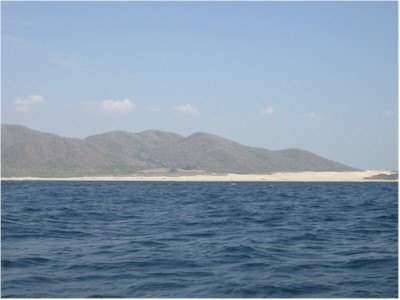
Sailing by a beautiful Gold Coast beach
 |
|
Sailing by a beautiful Gold Coast beach |
We motored out of La Cruz before sunrise, happy to be heading out of Banderas Bay and vowing to put our ailing transmission out of our minds. There were about 50 miles to go before we'd reach our anchorage for the night at Ipala, so we'd left early in the day, excited to be sailing south along Mexico's "Gold Coast" (the coast between Puerto Vallarta and Acapulco) where there were warm clean waters, soft sandy beaches, jungles, and crocodiles ahead!
About two hours later, the morning east wind out of the Banderas Bay finally picked up and we had a great sail to Cabo Corrientes, the cape which forms the southwest corner of Banderas Bay. This infamous "Cape of Currents" which can be quite rough and rowdy, was nice to us this day as we continued to sail mostly downwind around the cape in around 15-18 knots of wind. Once on the other side and 15 miles from our anchorage at Ipala, the wind suddenly died completely and we were left bobbing around in a glassy calm. Just as we got the motor started up, a fresh wind hit us from the southwest so up went the sails again and we zipped close-hauled the last two hours to Ipala. We realized we hadn't sailed upwind in months and it was quite a change from all the downwind sailing we'd done! Pelican likes to heel over quite a bit when sailing upwind -- it's amazing how much more effort it takes to move around the boat as she's hard on the wind as opposed to lazily rolling downwind. We were thankful our anchorage was just ahead and so had a good time racing through the wind waves.
Sailing down along this picturesque coast, we were thrilled to pass sea turtles slowing paddling along in the water. They look so out of place miles offshore, but that's where they live their whole lives, except when the females go to the beach to lay eggs. We wanted to get a better look at them, but the boat was moving much faster than they. We also saw brightly colored, probably highly poisonous sea snakes floating by and hoped we'd not see any of them in our anchorages south.
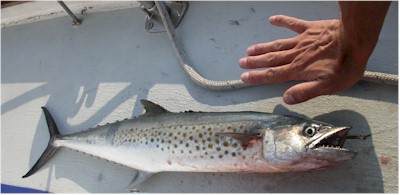 |
|
Soon to be scrumptious ceviche |
We caught three small skipjack tunas on the trip down to Ipala, but they were all too small to provide much eating so we threw them back to the sea. Just as we were pulling in our fishing line for the night, another booby bird snagged the hook! If you recall, we'd found a dead bird on the line just as we entered Banderas Bay, and here was another. This poor fellow we were able to free with what only seemed to us a small tear in the bottom of his throat, so we hoped he would be ok. We really hoped not to catch any more birds -- it was making fishing not so much fun.
Our night in Ipala was quiet and uneventful, then we set off the next morning for Chamela, another 50 miles south of us. Again, we motored in the dark early morning hours; when the sunrise brought the land breeze we were sailing south again. There were five or six boats anchored in Ipala and we'd all left around the same time for Chamela, so there was a sort of regatta south to Chamela. We had a south wind again, so spent the day making some large tacks back and forth. Even though Pelican was the smallest boat sailing, she didn't do too badly in keeping up with all the larger boats. In fact, when we had passed a couple of the larger boats, they magically started sailing directly into the wind, no doubt with the help of their diesels. Hmmm....
We saw a number of whales on the way down, including one that surfaced only about 100 feet off our port side. Always an awesome sight, no matter how many you've seen.
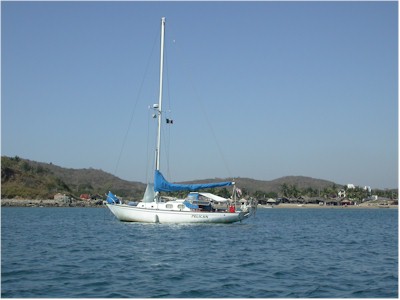 |
|
Pelican enjoying the Chamela breeze |
This day we were successful at fishing, having caught a small, 8 lb. Pacific Sierra that turned out to make two delicious meals, including our first attempt at making ceviche. A popular dish on this coast, in which the fish is marinated and "cooked" with lime juice, then mixed with tomatoes, cilantro, olive oil and other ingredients for a delicious cold meal, usually served atop crisp tostadas.
As the evening brought lighter winds, we drifted along the last few miles to our anchorage in Chamela, as long as our patience would let us. Just before sunset, we dropped the anchor in 25 feet of blue-green water so clear we could see the bottom right under the boat. We relaxed at sunset with a couple of cold beers and took in the beauty of our new spot anchored off a large circular golden beach lined with palm trees, with a full moon rising over the purple-blue mountains in the east. It was a beautiful end to a fun day passage.
Chamela was a lovely peaceful anchorage and we decided to stay a week as soon as we arrived. Ashore there were a number of palapa seafood restaurants that were mostly empty during the week. Then on Saturday morning until sunset on Sunday, the beach and surrounding palapas were filled with Mexican families playing on the beach and in the warm surf. Ashore we explored the small town of Punta Perula which had several small groceries and a fresh tortilla shop. It was a quiet, sleepy beachside town with only one paved road running parallel to the beach. The large circular bay was very pretty, with sand like light brown sugar and big white surf rolling along the shore. We could sit on the warm sand and watch the surf crash for what seemed like hours.
The clean clear water was like bath water, at least 80 degrees F and we spent nearly every afternoon going for a swim in just our bathing suits -- no wetsuits needed at all! One afternoon we were snorkeling around the boat, scrubbing the slime off Pelican's waterline, Michael checking zincs and scraping barnacles off our prop. He dove down once all the way to our anchor and happily confirmed it was well set. When Michael got out of the water after an hour and a half, he had another attack of dizziness, vertigo and nausea. Just like in La Cruz, it lasted all afternoon and he wasn't able to quit throwing up until the Scopolamine patch we stuck behind his ear kicked in.
|
Sleepy Punta Perula street |
The next day he was nearly recovered, but one of his ears now had what he reported to be severe ringing and hearing loss. We knew it was time to see a doctor when we got down to Tenacatita the following week.
A few evenings later we were having dinner with our friends on their boat Swamp Angel. Sometime during dessert, we felt the mast do a funny little shake, like something had grabbed the boat underneath and shook it a few times. It was not noticeable enough for anyone to say anything and I just marked it down to their boat reacting differently than ours to a wave or something. When we got back to Pelican shortly after, we turned on one of the evening SSB nets and found out there had been a 7.6 magnitude earthquake, centered near Colima about 70 miles south of us. It was then that we noticed that all the dogs on shore were barking up a storm and all the lights had gone out. We hoped the little town had not suffered too much damage! We were thankful to be on the water and not in one of the Mexican buildings, many of which are a bit sketchy construction-wise to say the least. However, there was a fast rumor of a tsunami hitting the coast, but by the time the radio waves were humming with the news, all realized that it would have passed hours before, right after the earthquake, so we were safe after all.
A walk through the small village the next day revealed no new obvious damage. All the buildings that had fallen down looked like they'd been that way for a while, as there are always many of in whichever Mexican town or city you are in.
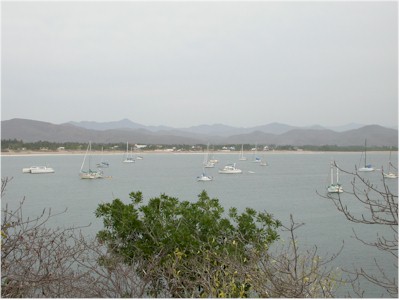 |
|
Chamela anchorage on a calm day |
While walking through town the next day on our thrice-weekly ice-cream bar run, we learned from some other cruisers that a friend of ours, Rik on Dikenga, a beautiful Tayana 37, had ended up on the beach at Punta de Mita in Banderas Bay late the previous night. Luckily Rik was okay, but his boat had been pounded for hours against the sand by the large surf there and the boat was likely to have been lost. We heard later that his battered boat had managed to get towed into Puerto Vallarta and lifted from the water into the yard there but it was still not known if she'd be able to float again. This was a sad sad reminder to us how quickly paradise can turn into hell and how fast cruising dreams can literally be on the rocks.
The next day we had toyed with the idea of moving on south the 20 miles to Tenacatita, where we had planned to relax for about a month as everyone who'd been there had told us it was their most favorite anchorage on the coast. We'd been in Chamela a week and so woke up that morning to listen to the weather to see what the wind was going to do that day. As predicted, by 1000 the wind had picked up from the SE, the exact direction we needed to travel so we decided to wait another day. But as the morning wore on, the winds continued to rise until they were blowing 25 knots directly into the anchorage at Chamela. Not protected by land from the SE, Pelican was soon bucking into 3 - 5' wind waves. Our peaceful anchorage now turned into a boiling froth, we followed the parade of boats heading down to the islands in the south part of the bay. Cranking in the anchor chain with our manual windlass was an adventure; Sara in her swimsuit was clinging to the bucking bow, cranking in the chain as spray and waves were flying everywhere as Michael had the boat in forward to make it easier to crank the windlass. At least the water was warm! A few miles across the windy bay, we tucked behind the lee of the islands with about 20 other boats in an anchorage reported as having room for three. But, happily protected from the wind waves, we just kept an eye on all our neighbors and waited for the winds to subside.
|
Sharing cervezas with Maajhi-Ré |
We put off our trip to Tenacatita another day as our friends on Waking Dream had just arrived. They had had a thoroughly miserable beat down the coast the day before; it had taken them 24 hours to travel the 50 miles from Ipala (what should have taken only 8-10 hours) as they'd had to sail against 30 knot winds and 10' wind waves with a stalled engine. Needless to say, we helped them enjoy a few beers on the beach the following afternoon to recover.
A game of beach volleyball with other cruisers delayed our departure another 24 hours.
The following day being Superbowl Sunday, we met some friends at a restaurant at an R/V park down the beach, our main motivation being the free hot showers the trailer park offered. We also looked forward to the commercials normally shown during the Superbowl, but the R/V park was showing the game via Canadian satellite television which wasn't showing the million-dollar commercials. We drowned our disappointment in ceviche, guacamole and beer. We admit we cannot report on what teams were playing nor who won.
All during the evening we noticed that the swell breaking on the beach was getting bigger and bigger and weren't looking forward to launching the dinghy through the surf in the dark. Normally we had little problem with getting the dinghy through the surf to land on the beach or out to the boat. The trick is just to wait until the set of larger waves is over and go in or out on the smaller waves. Also the trick is to just be prepared to get wet and walk the dinghy out into the waves as far as you can. But getting out at night was a whole different problem as it was too dark to see the size of the waves we were against.
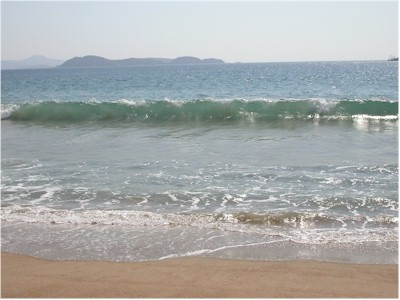 |
|
Watch out for this one! |
After the game, we nervously walked the dinghy out into the dark surf. A wave broke under us, getting Michael standing in the water soaked to his chin, but only a little water made it into the dinghy. Sara jumped in in the dinghy and started the outboard, but, hitting the throttle the outboard DIED, at the worst possible moment of course as the surf was rolling at us and we needed to get going before we got stuck in the crest of a wave and flipped. Luckily she got it started on the next pull and gunned the outboard as Michael jumped in. We throttled it over the next building wave, hoping to get over it before the growing crest broke. We seemed to be climbing almost vertically up up up the face of the building wave, praying we'd make it over the top. Suddenly we were flying through the air over the top of the wave as it broke. We crashed down on the other side, happy to see the surf rolling behind us and delighted to still be afloat. We waved to the Mexican man shaking his head from the shore having watched the whole escapade and yelled "¡Si -- Muy peligroso!" in agreement with his earlier warning.
The next day our friends on Rouser arrived so a few more days were spent in Chamela catching up with those two.
Finally, on our two week anniversary in Chamela, we knew it was time to head south for Tenacatita. We got the dinghy up on the boat, said goodbye to our good friends who would be meeting us down in Tenacatita during the next week, and headed south for the last time on our Mexican cruise.